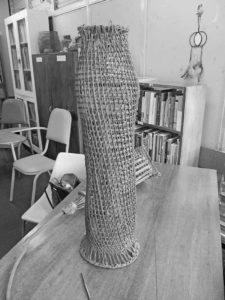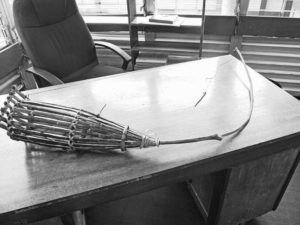Before the fishing rod of today, the indigenous people created ingenious fishing traps to sustain their daily lives. Some of these traps are extremely complex with one-way valves, bait chambers and floats, while others were primitively basic. Nevertheless, all fishing traps had one common trait – all evidently adapted to specific functions and ultimately different species of fish.

According to the late Denis Williams in his book “Prehistoric Guyana”, “the second great petroglyph tradition of the Northern Amazonia is represented by the Fish Trap Series…” which show the frequency and importance of fishing in indigenous communities.
Fishing was good in those early times. As early as 2000BC, small bands of “hunter-gatherers”, as Williams described them, would fish in pools, rivers and streams in the “productive rainforest” to trap their next meal.
The stratification of food refuse at the Pedra Pintada rock shelter on the Parima River in Region Nine shows occupation there to have lasted between 2,000 BC and1, 000 BC. This ‘refuse’ was said to indicate the heavy reliance on fish, fresh water snails and various small reptiles and mammals. This is further exemplified by the exploitation of the Kassikaityu River (Upper Takutu-Upper Essequibo), as illustrated by the Kassikaityu petroglyphs, which indicated “four kinds of fish traps: the Maswah, Box Trap, Cylindrical Fall Trap and the Spring Basket Trap”.
Aside from selective harvesting, the different types of traps indicated location, design, and baiting procedure utilised by the indigenous community.
Fish trap locations also differed in accordance with various habitats. Certain traps were anchored on the river bed, while others were supported on the platform of the water current or just below the surface, and sometimes barriers across waterfalls.

Fish trap locations and designs were specific to particular water bodies, depending on the geographic area, surface shapes and features. Not to mention, the indigenous fish traps and baiting procedure “evidenced by petrographic data” implies a “wide knowledge of the habits and haunts of various fish species and of their respective food preferences”.
Notably, the indigenous community was monitored in their fishing exhibitions to limit exploitation. According to Williams, “selective extraction was guaranteed by the imposition on a nearby rock exposure of a range of fish traps known to be effective in taking particular species of a given pool”.
Hence, choosing a fish trap for fishing was crucial to the hunt, the species caught and the amount taken home at the end of a given fishing trip. (Information taken from “Prehistoric Guiana” by Denis Williams)



